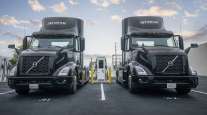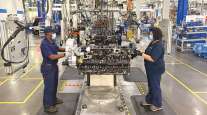Senior Reporter
Kenworth Displays T680 Hybrid-Electric Tractor

LONG BEACH, Calif. — Kenworth Truck Co. unveiled for the first time a prototype T680 tractor equipped with a parallel hybrid-electric propulsion system that is part of California’s Hybrid Electric Cargo Transport demonstration project.
MORE FROM ACT EXPO: DTNA showcases alternative-fuel Cascadia models
Kenworth, a unit of Paccar Inc., displayed the truck at its booth here during the ACT Expo on April 30-May 3.

Frong view of the T680 prototype (Truck PR/Flickr)
The T680 uses the Cummins Westport ISL G Near-Zero emissions engine fueled by compressed natural gas, in combination with a generator, to extend the truck’s battery range. The truck has a 30-mile zero emissions range using the electricity stored in the lithium-ion batteries. When the batteries are depleted, the near-zero emissions engine turns on to generate more energy and extend the truck’s range up to 250 miles, according to the Kirkland, Wash.-based company.
The engine’s exhaust emissions are 90% lower than the current Environmental Protection Agency’s NOx limit of 0.2 gram per brake horsepower-hour.
“We believe that in certain applications, such as drayage and regional hauling, the T680 HECT truck will be an excellent solution for local clean air regulations while delivering performance our customers expect,” Stephan Olsen, Kenworth director of product planning, said in a statement.
“Later this year, when the truck is placed into service with Total Transportation Services Inc. at the ports of Los Angeles and Long Beach, we anticipate it will perform equally, or even better than, current diesel trucks,” Olsen said.
BAE Systems is Kenworth’s partner in developing the truck’s parallel hybrid-electric propulsion system. The system’s energy management and control capabilities ensure that energy generated by the engine and regenerative braking system is appropriately distributed through the dual-rotor electric motor, resulting in lower fuel consumption.
The HECT project is funded in part by the Office of Energy Efficiency and Renewable Energy, the U.S. Department of Energy and the South Coast Air Quality Management District.





